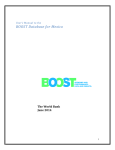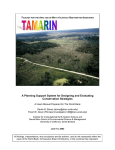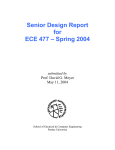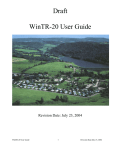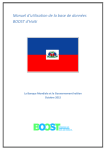Download User Manual`s in English
Transcript
The Republic of Seychelles A User Manual to the BOOST Expenditure Database World Bank and Government of Seychelles January 2013 1 Contents Tables and Figures .................................................................................................................. 3 1. Introduction ........................................................................................................................ 4 2. Structure of the Seychelles BOOST ................................................................................... 6 2.1 Particularities of the Seychelles BOOST ..................................................................... 9 3. How the database was built .............................................................................................. 10 3.1. Problems found in the raw data from a programming perspective ........................... 10 3.2. How the database was structured for coding purposes .............................................. 11 3.3. Codifying the ECON variables .................................................................................. 16 3.4. A word about the variables PROJECT1, and SOURCE_FIN1 & 2 .......................... 21 4. How to use the Seychelles BOOST database. Some examples ........................................ 23 4.1. Example 1. Trend Analysis by Ministry................................................................... 24 4.2. Example 2. Looking at a specific sector of activity .................................................. 25 4.3. Example 3. Identifying the Investment Budget ......................................................... 28 4.4. Example 4. IMF versus National ............................................................................... 29 2 Tables and Figures Figure 1. Mayor of Victoria budget lines, 2004-09 ................................................................ 7 Figure 2. Appeareance of Data After Building Basic Variables .......................................... 13 Figure 3. Appearance of Database After Building ECON Variables ................................... 18 Figure 4. Examining Government Expenditure across years ............................................... 24 Figure 5. ADMIN2 units under 'Ministry of Health' and 'Ministry of Health and Social Development' ........................................................................................................................ 26 Figure 6. Ministry of Health, adding ADMIN3 level ........................................................... 27 Figure 7. Expenditures of the Ministry of Education by ECON classification .................... 28 Table 1. Variable description ................................................................................................. 7 Table 2. Sections of the raw data .......................................................................................... 14 Table 3. How to map the different sections of the database with ECON variables ............. 17 Table 4. Section II. Examples............................................................................................... 19 The Seychelles BOOST was developed under the leadership of Mr. Patrick Payet ([email protected]), Deputy Comptroller at the Ministry of Finance, Trade and Investment, with the support of a World Bank team comprising of Sawkut Rojid ([email protected]), Massimo Mastruzzi ([email protected]), and Francisco Vazquez-Ahued ([email protected]). 3 1. Introduction The importance of timely and concise budget analysis to ensure an effective and efficient use of the budget has become increasingly clear over the years. Good public expenditure management (PEM) not only requires solid budget formulation and execution processes, it is equally crucial that budgets are monitored and spending is analyzed. Regular feedback allows decision makers to make sure that the budget delivers goods and services in an efficient and cost-effective manner. Countries are under pressure to improve efficiency in the composition of public sector absorption as the demand for public spending efficiency is increasing from stakeholders, moreso during the crisis periods. The World Bank has developed a simple new knowledge product to meet this demand. The underlying data tool is called “BOOST”. BOOST is a client-friendly, easy access Microsoft Excel-based public expenditure data analysis tool. BOOST covers all funds in the Budget, whether from tax revenues, internally generated funds or donor financed. BOOST collects and stores multi-year data from all budgetary finance sources in a single standard format. It takes data directly from the Government’s Treasury accounting system, using a full set of Treasury accounting codes for each expenditure item expressed in the client’s Chart of Accounts. Sub-components of the code are then used to classify planned budget, revised budget and expenditure data for each item of spending by: • level of Government (central or local Government), • administrative unit (a budget management center, typically a Ministry, Department, Agency, university, hospital, a school in some cases), • economic classification (using GFS-related or country-specific codes), • functional classification (sector and sub-sector COFOG-related or country-specific codes), • program classification, • by financing source (budget revenues, domestic or foreign borrowing, etc.), • by performance code (objective, target, output or program, MTEF code, etc). The BOOST for Seychelles has been created as part of the Public Expenditure Review (PER) exercise in 2012/13. The Seychelles’ BOOST is part of the global BOOST initiative. The initiative started in 2010 and as of September 2012, BOOST data bases had been created for more than twenty countries The Seychelles BOOST is the first one to include revenue and financing (i.e., bonds emissions and sale of assets to be included below the line) data. The development of the Seychelles BOOST started in March 2012 with a preliminary exploration of the data and was followed by various draft versions which were reconciliated with the data available in publicly available documents, including the fiscal table presented in the IMF’s last EEF report. Multiple workshops have been held across Government to validate the data and to obtain feedback on the user friendliness of the Seychelles BOOST. The Government of the Seychelles intends to update the database 4 regularly in coordination with the World Bank, as new data becomes available. The Government of Seychelles also intends to provide the BOOST in the public domain for transparency purpose as well as to initiate and facilitae research using the data. The BOOST will be helpful in opening new avenues of analysis and providing answers to important questions regarding the efficiency, equity, and effectiveness of spending. To ensure sustainability of the project, the World Bank has provided training to government officers from the Ministry of Finance, Ministry of Education, Ministry of Health and the statistical Office. This user manual is a tool which will facilitate updates in the future as new data becomes available, assist in undertaking data queries, and will help in building capacity to a wider audience by the staffs who have been trained. The manual is organized as follows: • • • Part II outlines the structure of the Seychelles budget. Part III outlines how the database was built using Excel. Part IV explains how to use the Seychelles BOOST with an Excel pivot table. . 5 2. Structure of the Seychelles BOOST The Seychelles BOOST includes expenditures and revenue executed by different agencies of the central government. The data is disaggregated in four levels of administrative classification, seven levels of economic classification, source of funding (only for projects for the development budget), and project (only for centralized payments, projects of the development budget, and debt items). The database includes two types of economic classification. The first one, which ends with the suffix “_IMF”, allows users to replicate the expenditure side of the IMF fiscal tables. The second one, which ends with the suffix “_NATIONAL”, allows users to reproduce fiscal tables according to the national fiscal accounting. There are basically two sources of differences between the IMF and the fiscal tables: • The recapitalizations of state-owned and private companies, which are accounted for as transfers in the national system and as equity investments by the IMF. • The expenditures of the autonomous government authorities. Prior to the restructuring of 2008, the treasury systems only recorded transfers to the autonomous government authorities. Prior to 2008, users can only see, for instance, the transfer of the central government to, for instance, the Office of the Mayor of Victoria, or the National Bureau of Statistics. As a result of the restructuring, autonomous government authorities are now compelled to register their expenditures in the treasury system, just like any other government agency. Starting in 2009, users can see the detailed expenditure breakdown of the Office of the Mayor of Victoria, or the National Bureau of Statistics. In order to keep continuity in the time series, the IMF continues to classify these expenditures as “transfers to autonomous government authorities.” To facilitate comparisons with IMF fiscal documents, the ECON variables ending with the suffix “_IMF” allow identifying the expenditures of the autonomous government authorities as transfers. In order to reflect the better recording of fiscal expenditures, the variables with the suffix “_NATIONAL” enable the user to see the detail of the autonomous government authorities. The second point deserves a detailed explanation. In the past, the Seychelles Government just registered the transfer as one single line and didn’t keep track of the expenditures. After a series of administrative reforms, however, autonomous government authorities are now compulsed to register their expenditures in the treasury systems. Figure 1 shows that, between 2004 and 2008, there is one budget line for “Mayor of Victoria” but, from 2009 onwards, the average number of lines for this ADMIN unit rises to 30. In order to keep continuity across years, the IMF keeps reporting these expenditures as transfers, even if it is possible to see the detailed spending of the autonomous government authorities for recent years. The _IMF variables aim to preserve that continuity. The _NATIONAL variables present the traditional breakdown by ECON classification (21 Compensation of employees; 22 Use 6 of Goods and Services, etc). For the years prior to 2009, the _NATIONAL variables register those expenditures as 22 Use of Goods and Services. Figure 1. Mayor of Victoria budget lines, 2004-09 For comparison purposes, Table 1 classifies the variables of BOOST-Seychelles and their description. Table 1. Variable description Global BOOST Variable Description Budgetary Divisions Year Above or below the line budtype econ0_imf econ1_imf econ2_imf Year Variable used to identify budget lines that need to be included above or below the line Recurrent or Development budget Revenue, Expenditure, or Changes in Net Worth, according to IMF fiscal table First level of economic classification, according to IMF fiscal table Second level of economic classification, according to IMF fiscal 7 econ3_imf econ4_imf econ5_imf econ6_imf econ0_national econ1_ national econ2_ national econ3_ national econ4_ national econ5_ national econ6_ national source_fin1 source_fin2 project1 table Third level of economic classification, according to IMF fiscal table Fourth level of economic classification, according to IMF fiscal table Fifth level of economic classification, according to IMF fiscal table Sixth level of economic classification, according to IMF fiscal table Revenue, Expenditure, or Changes in Net Worth, according to National fiscal table First level of economic classification, according to National fiscal table Second level of economic classification, according to National fiscal table Third level of economic classification, according to National fiscal table Fourth level of economic classification, according to National fiscal table Fifth level of economic classification, according to National fiscal table Sixth level of economic classification, according to National fiscal table Source of Funding: first level Source of Funding: second level Identifies: -Projects in the development budget -Beneficiaries of bail-outs in the “bail out budget” (chapters 54 to 60 of the budget) -Beneficiaries of debt payments -Takes value NA otherwise Administrative Divisions admin1 admin2 admin3 admin4 First level of the Administrative classification Second level of the Administrative classification Third level of the Administrative classification Fourth level of the Administrative classification Expenditure amounts Debit budgeted Credit budgeted Debit executed Credit executed Debit budgeted amounts (available only from 2009 onwards) Credit budgeted amounts (available only from 2009 onwards) Debit executed amounts Credit executed amounts 8 2.1 Particularities of the Seychelles BOOST Compared with other BOOST datasets, the Seychelles BOOST presents a number of particularities: • Inclusion of revenues and financing data. • The possibility to replicate the expenditure side of the IMF fiscal tables. • The database uses the GFSM 2001 classification. • The inclusion of expenditures that are not recorded in the treasury systems, such as the equity investments of SEYPEC. • The main limitations of BOOST-Seychelles are: o The programmed expenditure and revenue amounts are included from 2009 onwards. o The in-kind contributions to the Development Budget are included from 2009 onwards. o The database contains no functional classification because it is not used by the Seychelles’ authorities for the moment. It should be mentioned, however, that the Seychelles authorities have plans to introduce the COFOG classification progressively since 2013, when the Development Budget will be classified according to this method. o The constant changes in the administrative chart of accounts make timeseries analysis complicated and not as straightforward as in other BOOST databases. There are plans to set a new chart of accounts, with clear ADMIN classifications that last for a long period of time, in 2013. o Given the loss of institutional memory within the Government of Seychelles, it was not possible to identify some donors to the development budget for the period between 2004 and 2006. o Given the loss of institutional memory within the Government of Seychelles, only 2011 was fully reconciled with the IMF fiscal table. In future versions of the Seychelles BOOST (some of) these particularities may be addressed: • Backwards compatibility of the ADMIN classification. When the new ADMIN chart of accounts becomes available, it will be necessary to map the old ADMIN codes with the new ones. This exercise will have many limitations, as some ADMIN units have disappeared over the last years, or have been merged with other ones. 9 3. How the database was built The Seychelles database was built manually at great cost. Contrary to other databases, which were built using STATA do files or Excel macros, the Seychelles database had to be done by looking at the data on a line-by-line basis. This section is divided in four parts. The first part describes the main obstacles found by the team from a programming and coding perspective. The second part, describes how the database was structured to facilitate coding in Excel. The third part will describe how the coding of the ECON classification was done. Last, the fourth part will be devoted to variables PROJECT1, and SOURCE_FIN1 and 2. 3.1. Problems found in the raw data from a programming perspective Constant changes in the ADMIN chart of accounts. Example: between 2004 and 2011, the Ministry in charge of Environment has changed its name and administrative functions three times. Between 2004 and 2006 it was called “Ministry of Environment and Natural Resources”; between 2007 and 2010, its name changed to “Ministry of Environment, Natural Resources and Transport”, and in 2011, it became the “Ministry of Home Affairs, Environment, and Transport,” when it absorbed the Department of Internal Affairs, up until that moment an independent unit. The changes of names are the easy part to deal with. The problem, from a programming perspective, was that the changes obviously brought with them changes in the administrative structure of the Ministry. Between 2004 and 2006, the Division of Nature and Conservation was at the ADMIN2 level; in 2007, it became an ADMIN3 under the Environment division, and became a deconcentrated organ in 2011. Code recycling was equally a problem. In 2004, for instance, code 02-40 represented the FTC division in the Ministry of Environment and Natural Resources. In 2009 and 2010, 02-40 represented the Department of Agriculture and Fisheries within the Natural Resources Division of the Ministry of Environment, Natural Resources and Transport. Code recycling in the debt and centralized payments budgets. Code recycling was particularly prevalent in the debt payments budget, particularly after the defaults. In 2004, code 23-10-8941 represented interest payments to a bond expiring that year. Between 2005, after the first restructuring, and 2007, that same code represented interest payments to a diferent bond. Centralized payments showed a different problem. Between 2004 and 2008, codes 21-XXXXXX represented the budget of the constitutional appointees (Ombudsman, National Assembly, and others). From 2009 onwards, codes 21-XX-XXXX started representing centralized payments. The fact that the imputation codes in the revenue side changed from year to year, which prevented the use of automatic codes. 10 Example: In the raw data, revenues derived from selling video cassette stickers are represented by 5 different codes: Year 2004 2005 2005 2006 2009 2010 Account ID 86-18-5001 86-09-2001 86-18-5001 86-09-2001 86-14-7303 86-14-7303 Account Description MEP:VIDEO CASETTE STICKERS MOHSS.VIDEO CASSETTE STICKERS MEP:VIDEO CASETTE STICKERS AF:DITTC:VIDEO CASSETTE STICKERS MND:VIDEO CASSETTE STICKERS FC.MND.VIDEO CASSETTE STICKERS These issues pushed the team to proceed to reconcile and codify the data manually. The Seychellois government has made tremendous efforts to have a more stable nomenclature, and it is likely that the introduction of the new chart of accounts makes the process to update the BOOST database more straightforward in the future. 3.2. How the database was structured for coding purposes The steps performed to build the database are: 1 1. Create a new Excel file with the following variables: • YEAR • Account ID • Account Description • Debit Executed • Credit Executed • Debit Budgeted • Credit Budgeted • ADMIN1 • ADMIN2 • ADMIN3 • ADMIN4 • Ministry • Division • Four Digits • BUDTYPE • Above and below the line • ECON0_IMF • ECON1_IMF 1 This part of the manual describes only the process to create the database for 2011. Given the problems described above, particularly the ones pertaining to code recycling, the process could not be automatized for the previous years. It should be mentionted, however, that the procedures followed by the team were very similar for the years 2004-10. 11 • • • • • • • • • • • • • • • ECON2_IMF ECON3_IMF ECON4_IMF ECON5_IMF ECON6_IMF ECON0_NATIONAL ECON1_NATIONAL ECON2_NATIONAL ECON3_NATIONAL ECON4_NATIONAL ECON5_NATIONAL ECON6_NATIONAL PROJECT1 SOURCE_FIN1 SOURCE_FIN2 2. Copy, from the original file provided by the authorities, the values included in columns YEAR, Account ID, Account Description, Debit Executed, Credit Executed, Debit Budgeted, Credit Budgeted, and ADMIN1 through 4. Given the problems with the chart of accounts described above, variables ADMIN1 through 4 are ad hoc variables created by the authorities at the explicit request of the BOOST Team. 3. The variables that will guide your work will be “Ministry”, “Division”, and “Four digits”. 2 The first thing to do is to break down the ACCOUNT ID variable into these three elements, so that we can manage the database. To do that, we need to do that: 3.1. In cell L2, in variable “Ministry”. type the following formula =LEFT(B2, 2). Then drag until the end of the column. 3.2. In cell M1, create a variable named “Division”. In cell M2 type the following formula =LEFT(B2,5). Then drag until the end of the column. 3.3. In cell N1, create a variable named “4 digits”. In cell N2 type the following formula =RIGHT(B2,4). You have now three variables that will allow you to manipulate the database and know where you are in the database. Assuming you didn’t make any modifications to the file, it should look like this: 2 As it will be explained below, the names “Ministry” and “Division” do not necessarily stand for ministries or admin divisions, but using these denominations are useful to guide our work. 12 Figure 2. Appeareance of Data After Building Basic Variables 4. For purposes of coding, the Seychellois database is composed, grosso modo, of ten parts: I. The expenditures of line ministries and constitutional appointees. In variable Ministry, these are contained in the cells with values ranging from 01 to 20. II. Centralized payments of high-level officials salaries and goods and services, included in the cells whose variable division takes the values of 21-00 or 2101 III. Social programs and transfers to the autonomous authorities and parastatals. These are contained in the remaining rows where “Ministry” is equal to 21, and all of the lines with code equal to 22. IV. Debt payments, contained in the cells with values 23 and 24. V. Grants, contained in the cells with value 25 VI. The execution of development projects, contained in the cells with values 26 – 50. VII. The bail-outs of state-owned and private companies, included in cells with values 54 and 55. VIII. The financing part, contained in the cells with values 61 – 80. IX. The revenue part, contained in the cells with values 81 – 92. X. The end of year balances and the receipts from privatizations, contained in the cells with values 93 – 99. 13 We will break up the database later on in these ten parts, and the vlookups to be used will depend a lot on what part of the database you are looking at. Table 2 summarizes the 10 sections of the database, and provides an indication on the classification by budget type and the line items that need to be included above or below the line. Table 2. Sections of the raw data Number I II III Name of section Expenditures of line ministries and constitutional appointees Centralized payments How to identify it Ministry equals to 01-20 Budtype Recurrent Budget Above or below the line Above the line Division equals to 21-00 and 21-01 *Division equals to 2102 and above, *Ministry equals to 22 Recurrent Budget Recurrent Budget Above the line Ministry equals to 23 -24 Recurrent Budget *Both: -Interest payments (division equals to 23-10 and 24-10) go above the line -Principal payments (division equals to 23-20 and 24-20) go below the line -Administrative costs of debt restructuring (Account ID equals 24-20-000) goes above the line *Both: -Development Fund (Account ID equals 25-00000) goes “stock” -Everything else, goes above the line Above the line IV Social Programs and transfers to autonomous authorities and parastatals Debt payments V Grants received Ministry equals to 25 Developm ent Grants VI Execution of grants received Bail-outs Ministry equals to 26-50 Financing, imprest, and suspense accounts Revenue Ministry equals to 61-80 Developm ent Grants Recurrent Budget Recurrent Budget Privatization receipts and cash balances at the end of the year Ministry equals to 93-99 VII VIII IX X Ministry equals to 54-60 Ministry equals to 81-92 Recurrent Budget Recurrent Budget Above the line Above the line Below the line Above the line Either Stock or Below the line (privatization receipts are included above the line for some years, but given loss of institutional memory, we couldn’t retrieve that information) 14 5. Break down the database in the ten sections described above. To do that, insert five lines between each section, and copy and paste the headers of row 1 at the beginning of every section. 6. The first thing to do is to determine what part of the budget is financed through grants, and what part is financed through the recurrent budget. With the exception of sections 5 (Grants, for which Ministry is equal to 25) and 6 (Execution of development budgets, for which Ministry is equal to 26 – 50), everything else is financed by the recurrent budget. Under variable “BUDTYPE”, write “Recurrent Budget” for all the sections of the database, with the exception of sections 5 and 5, for which you will write “Grants.” 7. We now need to identify what goes above and below the line. This is an extremely important part in the process of creating the database and needs to be done carefully. This is how you need to fill the column: 7.1. In sections 1 to 3 ( “line ministries spending”, “centralized payments of salaries and goods and services”, and “transfers to autonomous and parastatals”), just type “Above the line”. 7.2. In section “Debt payments, apply the following VLOOKUP: =VLOOKUP(M5503,Sheet2!$E$2:$F$5,2,FALSE) You are basically sending principal payments (codes 23-20 and 24-20 )below the line, and interest payments (codes 23-10 and 24-10) above the line) 3. 7.3. In the section “grants” (cells where Ministry is equal to 25), Write “Stock” the row corresponding to code 25-00-000, and “Above the line” for all the other lines of data. 7.4. In the section for the execution of development projects, contained in the cells with values 26 – 50, type “Above the line”. 7.5. In the financing part and balances part (cells with values 61 – 80 and 93 – 99), write “below the line”. 7.6. In the part for revenues (cells with values 81 – 92), write “Above the line”. 7.7. In the part for privatization proceeds and end-of-year balances (cells where “Ministry” is equal to 93-99), write “Below the line” 8. The next thing to do is to identify the ADMIN units in the database. For sections 1 – 3, we will rely on the information provided by the Government. For the rest of the sections, this is what we need to do: 8.1. Section 4 (Debt payments). Write “Public Debt Payments”in ADMIN1 and fill with NA the other ADMIN variables. 3 WARNING: THIS CODE WILL SEND THE ADMINISTRATIVE COSTS OF DEBT RESTRUCTURING (Account ID equals to 24-20-000) BELOW THE LINE. YOU WILL NEED TO CORRECT THIS PROBLEM MANUALLY (I.E., WRITE “Above the line in the row where Account ID equals to 24-00-000). 15 8.2. Section 5 (Grants received). Write “Development Funds Receipts” in ADMIN1 and fill with NA the other ADMIN variables. 8.3. Section 6 (Execution of Investment projects). 8.3.1. Modify the formula for variable “Ministry” to =MID(B5693,7,2) and drag until the end of the section. 8.3.2. Apply the following VLOOKUP in ADMIN1: =vlookup(L5693,Sheet2!$I$2:$J$20,2,FALSO) 4 8.3.3. It is possible to identify the ADMIN2 for some investment projects. This has to be done after reviewing carefully the CAPEX files. 8.4. Section 7 (Bail-outs). Write “Ministry of Finance and Trade” in ADMIN1 and fill with NA the other ADMIN variables. 8.5. Section 8 (Finanincing). As this part of the database goes below the line, just type NA in all the ADMIN variables. 8.6. Section 9 (Revenue). 8.6.1. Modify the formula for variable “Ministry” to =MID(B6845,7,2) and drag until the end of the section. 8.6.2. Apply the following VLOOKUP in ADMIN1: =vlookup(L6845,Sheet2!$I$2:$J$20,2,FALSO) 8.6.3. Beware: You will need to change manually the cells for which the VLOOKUP retrieves “Ministry of Finance”. Instead, you will need to allocate these lines to the Seychelles Revenue Commission as follows: ADMIN1 Autonomous Government Authorities ADMIN2 Category 2: Regulatory Bodies ADMIN3 Seychelles Revenue Commission 8.7. Section 10 (cash balances and privatization proceeds). As this part of the database goes below the line, just type NA in all the ADMIN variables. 3.3. Codifying the ECON variables 9. As it was mentioned before, the Seychelles database includes two sets of ECON variables. The first set, which includes the suffix _IMF at the end, allows users to reproduce the IMF fiscal tables. This set of variables considers the expenditures of autonomous bodies as transfers. The second set, which includes the suffix _NATIONAL at the end, allows to identify the spending of the autonomous agencies at the item level. Both sets of ECON variables use the GFSM 2001 classification. In fact, The _IMF and _NATIONAL classification is basically the same with the exception of sections 2 (“centralized payments”), 3 (“transfers to autonomous authorities and 4 BEWARE: This VLOOKUP will give you some #N/A cells. These will correspond to investment projects executed by the constitutional appointees. You will need to find out which manually in the CAPEX files. Also, some of the projects identified with the Ministry of Environment were in reality executed by the Seychelles Agricultural Agency, a parastatal. You will have to check that as well in the CAPEX files. 16 parastatals”), and 7 (“bail-outs). The paragraphs below indicate how to assign econ codes to all the sections of the database. 10. The introduction of GFSM is a new development in Seychelles. BOOST is the first attempt to reconcile the old chart of accounts, which had no structure and changed from year to year, to GFSM. Most of the work was done using VLOOKUPS to link the original classification with the GFSM nomenclature provided in three files provided by the Authorities: “Bridged_Treasury_GFS(2)”, “Copy of Economic_Classification_ver_17”, and “Copy of Revenue Classification”. The table below specifies the mapping relation between the different sections of the database and the three files provided by the authorities. Table 3. How to map the different sections of the database with ECON variables Section Mapped to file IS _IMF classification equal to _NATIONAL? I. Expenditures of line ministries and constitutional appointees Copy of Economic_Classification_ver_17 Yes II. Centralized payments None. Done manually Yes III. Social Programs and transfers to autonomous authorities and parastatals No VIII. Financing *_IMF: Done manually *_National: -Done manually for lines with codes 2100 and 21-01 -Bridged_Treasury_GFS(2) for lines with codes 22 None. VLOOKUPs set up after discussion with authorities None. VLOOKUPs set up after discussion with authorities None. VLOOKUPs set up after discussion with authorities *_IMF: Done manually *_National: Done manually Bridged_Treasury_GFS(2) IX. Revenue Copy of Revenue Classification Yes X. Proceeds from privatization and balances at the end of the year Bridged_Treasury_GFS(2) Yes IV. Debt Payments V. Grants Received VI. Execution of Development Projects VII. Bailouts Yes Yes Yes No Yes 17 11. Section I (Expenditures of line ministries and constitutional appointees) was filled out using VLOOKUPS linking variable “four digits” with the ECON codes provided in the new chart of accounts. To fill down the _IMF variables, you will need to write the following VLOOKUPS between Columns Q2 and W2, and drag down: Q2 =VLOOKUP($N2,Sheet2!$N$3:$U$209,2,FALSE) R2 =VLOOKUP($N2,Sheet2!$N$3:$U$209,3,FALSE) S2 =VLOOKUP($N2,Sheet2!$N$3:$U$209,4,FALSE) T2 =VLOOKUP($N2,Sheet2!$N$3:$U$209,5,FALSE) U2 =VLOOKUP($N2,Sheet2!$N$3:$U$209,6,FALSE) V2 =VLOOKUP($N2,Sheet2!$N$3:$U$209,7,FALSE) W2 =VLOOKUP($N2,Sheet2!$N$3:$U$209,8,FALSE) After you drag down, your screen should look like this: Figure 3. Appearance of Database After Building ECON Variables This line of codes will result in several cells with values “N/A”. The reason for this is that not all the codes are mapped to GFSM 2001. Some codes starting with 85, 86, and 87 were not mapped to GFSM 2001 because they refer to programs instead of ECON items. Traditionally, these lines have been reported as expenditures in goods and services to the IMF. Therefore, the BOOST Team agreed with the Seychelles authorities, that the database would identify these items as “Other Goods and Services not reclassifed in the new chart of accounts” in ECON2, and ECON3 would include the original name of the item. After filling down the variables with values #N/A with real variable descriptions, copy them to the _NATIONAL variables. 18 12. Section II needs to be done manually, line by line. Lines for which “Division” is equal to 21-00 include different compensations to high level officials, including the President of the Republlic. Lines for which variable variable “Division” is equal to 21-01 include purchase of goods and services. 12.1. For lines where division is equal to 21-00, you will need to distinguish between “wages and salaries” and “compensation and gratuities”. The only way to do it is looking at variable “Account description”. Descriptions that start with WS refer to “wages and salaries”; descriptions that start with CGW refer to “compensations and gratuities”. You need to identify that in variable ECON2, and variable ECON3 must include the name of the agency. This applies both to the IMF and NATIONAL variables. The table below should serve as an example: Table 4. Section II. Examples Account ID Account Description ADMIN1 21-000101 WS.CAP.PRESIDENTIAL Centralized Payments 21 21-00 0101 21-000102 WS.CAP.MINISTERIAL Centralized Payments 21 21-00 0102 21-000103 WS.CAP.CONSTITUTIONAL Centralized APPOINTEES Payments 21 21-00 0103 21-000104 WS.CAP.ATTORNEY GENERAL'S Centralized Payments 21 21-00 0104 21-000110 CGW.STATE HOUSE ADMINISTRATION Centralized Payments 21 21-00 0110 Ministry Division Four digits ECON0_IMF ECON1_IMF 21 Compensation 2 Expense of Employees 21 Compensation 2 Expense of Employees 21 Compensation 2 Expense of Employees 21 Compensation 2 Expense of Employees 21 Compensation 2 Expense of Employees ECON2_IMF ECON3_IMF Wages and Salaries Presidental Wages and Salaries Ministerial Wages and Salaries Constitutional Apppointees Wages and Attorney Salaries General Compensation and State House Gratuities 12.2. Lines where division is equal to 21-01 refer all to goods and services centrally purchased. File “Guide” shows how they should be registered in the database. 13. Section III (lines where Ministry is equal to 21, and “Division” is equal and higher than 21-02, and lines where Ministry is equal to 22) is the one where the differences between the IMF and the National classification are located.In the IMF classification, all of these lines should be classified simply as “Transfers” in ECON1. In ECON2, however, the following adjustments need to be made: 13.1. Division = 21 -02 should say “Social Program of Central Government” in ECON2_IMF. The name of the program (to be retrieved manually from Account Description) needs to be registered under variable PROJECT1. 13.2. Division = 21-03 should say “Benefits and Programs of Social Security Fund” in ECON2_IMF. The name of the program (to be retrieved manually from Account Description) needs to be registered under variable PROJECT1. 19 13.3. Ministry = 22 should say “Transfers to public sector from central government” in ECON3_IMF 13.4. For the _NATIONAL variables, you will need to do a VLOOKUP to link the Account ID with the GFS bridge tables provided by the Government (see file “guide” for more information). 14. In Section IV (debt payments), make a series of VLOOKUPS that identify the payments to internal and external debt (see file guide for more clarification). Beware of code 24-20-0000. The VLOOKUP in place in the file identifies this line as a payment of principal to foreign debt. In reality, this should be classified as a payment for goods and services in both _IMF and _NATIONAL. 15. In Section V (grants received), type “1 Revenue” under ECON0, and “13 Grants” under ECON1. Then drag down. Watch out: when you drag down, make sure that you just copy the cells. The Excel default command is to continue the series (i.e., you will have 2 Revenue in the second cell, 3 Revenue in the third one, and so on…). You will need to correct for that; how to do that depends on the version of Excel you are using. 16. In Section VI of the development budget, type the following: ECON0 “3 Changes in Net Worth” ECON1 “31 Non-Financial Assets” ECON2 “311 Fixed Assets” ECON3 “3111 Buildings and Infrastructures” 5 Then, drag the formula down. Again, be sure that you are just copying the values, not continuing the series. 17. Section VII (bailouts) needs to be done manually with the authorities. This part is not included in any of the three files provided by the authorities. 18. In Section VIII (financing), you will need to do a VLOOKUP to link the Account ID with the nomenclature of file Bridged_Treasury_GFS(2) (see file “guide” for more information). 19. In Section IX (revenue), you will need to do a VLOOKUP to link the Account ID with the nomenclature of file Copy of Revenue Classification (see file “guide” for more information). 5 A quick overview of the development budget reveals that not all of the projects are physical investments. Some of them, like the organization of workshops, or the elaboration of bilingual dictionaries, could be classified as purchases of goods and services. The Seychellois Government is working on an accurate classification of the projects included in the development budget, which include the introduction of COFOG. 20 20. In Section X (proceeds from privatizations and balances), you will need to do a VLOOKUP to link the Account ID with the nomenclature of file Bridged_Treasury_GFS(2) (see file “guide” for more information). 3.4. A word about the variables PROJECT1, and SOURCE_FIN1 & 2 One of the main features of BOOST databases is the inclusion of variables identifying budget lines by project and source of funding, where available. The Seychelles BOOST takes advantage of that amazing innovation. In line with other BOOST databases, variables SOURCE_FIN1 and 2 identify the source of funding for the investment projects of the development budget (section VI of databases, lines where Ministry equals 26 – 50). Like other sections of the database, this part was done manually. The way it was done was the following: • • • Look for the project name (Account Description) or the amount executed in the CAPEX files. With the exception of the lines where variable division is equal to 30-01, Copy and paste the source of funding as it appears there. For lines where variable division is equal to 30-01, type “Government of Seychelles” under SOURCE_FIN1, and “Domestic” under SOURCE_FIN2. In line with other BOOST databases, and as its name indicates, variable PROJECT1 identifies the investment projects for a given budget line. In addition, this variable identifies other items of interest in different section of the database, as the table below indicates. Section of database What does variable PROJECT1 identifies in this section? I. Expenditures of line ministries and constitutional appointees Nothing II. Centralized payments Nothing III. Social Programs and transfers to autonomous authorities and parastatals Social program For lines where “Division” is equal to 2102 and 21-03, copy the contents of cell “Account Description” IV. Debt Payments Bond or loan to which a Copy the contents of cell How was the information retrieved from the database 21 payment was made “Account Description” V. Grants Received Nothing VI. Execution of Development Projects Name of project Copy the contents of cell “Account Description” and double check with CAPEX files VII. Bailouts Name of enterprise receiving public money Copy the contents of cell Account Description VIII. Financing Nothing IX. Revenue Nothing X. Proceeds from privatization and balances at the end of the year Nothing 22 4. How to use the Seychelles BOOST database. Some examples BOOST-Seychelles consists of three Excel spreadsheets: the first one, called “TOC”, describes the variables of the database. The second one, called “Raw Data”, contains information at the line level and can be used by experts in budget and Excel to do in-depth analyses. “Raw Data” also feeds into the sheet “Pivot”, which allows users to do customized tables using Excel’s Pivot Table functionality. Most users will only use the Pivot sheet. A PivotTable report is an interactive way to quickly summarize large amounts of data. Use a PivotTable report to analyze numerical data in detail and to answer unanticipated questions about your data. A PivotTable report is especially designed for: • Querying large amounts of data in many user-friendly ways • Subtotaling and aggregating numeric data, summarizing data by categories and subcategories, and creating custom calculations and formulas. • Expanding and collapsing levels of data to focus your results, and drilling down to details from the summary data for areas of interest to you. • Moving rows to columns or columns to rows (or “pivoting”) to see different summaries of the source data. • Filtering, sorting, grouping, and conditionally formatting the most useful and interesting subset of data to enable you to focus on the information that you want. Presenting concise, attractive, and annotated online or printed reports. 6 • PivotTables are straightforward and easy to use and allow for quick, customizable analyses of large amounts of data. This section presents several examples of using the BOOST PivotTable interface to general custom reports. With BOOST, as with many things in life, the best way to learn is by doing. 7 6 For more information on Excel PivotTables, please consult the help function in Microsoft Excel or this helpful overview of the Microsoft website: http://office.microsoft.com/en-us/excel-help/overview-ofpivottable-and- pivotchart-reports-HP010177384.aspx. 7 The minimum technical requirements for using BOOST-Seychelles are as follows: (i) a computer with at least 1 GB of RAM (2 GB preferred); (ii) Microsoft Excel version 2007 or later (or similar database software that allows loading of files with at least one million lines of data). 23 4.1. Example 1. Trend Analysis by Ministry Figure 3 below presents an example of time trend analysis at the macro level. It reports total government expenditures from 2004 to 2011, broken down by the top- level administrative classification. To generate this PivotTable, value “Above the line” of variable Above and Below the line is used as a filter; ADMIN1 is placed in the Row Labels box, Year in the Column Labels box, and the values in the body of the table consist of the sum of the Debit Executed variable. Figure 4. Examining Government Expenditure across years 24 4.2. Example 2. Looking at a specific sector of activity One of the main limitations of this database is that it doesn’t include a functional classification. If one adds the fact that Ministries and Agencies have been reorganized several times over the last years, following up the evolution of spending in a given sector might be complicated. Fortunately, however, some if not most ADMIN units at the lower levels remained constant. This example will try to analyze the evolution of spending in the sector of Health, which has gone through two ADMIN changes since 2004: between 2004 and 2005, it was named “Ministry of Health”. Between 2006 and 2010, it was named “Ministry of Health and Social Development”, when it absorbed the functions of the Social Development Agency. Last, in 2011, it became Ministry of Health Again, but only with two ADMIN2 units. To generate a pivot table that only looks at the expenditures in health, you need to follow the following steps: • Value “Above the line” of variable Above and Below the line is used as a first filter. • Variable ADMIN1 is used as a second filter, as well. Here, you have to use “Ministry of Health” and “Ministry of Health and Social Development” as filtering units. • Variable ADMIN2 is placed in the Row Labels box. • Variable Year is placed in the Column Labels box. • Last, the values in the body of the table consist of the sum of the Debit Executed variable. At this point, you will note you have good time series only for “NA”, which runs from 2004 to 2011 and includes the development projects carried out under the flag of the Ministry, and a relatively decent time series for the Public Health Commission (2004-10). These two time series are highlighted in yellow below. The reason behind the lack of information for the other ADMIN2 units is an admninistrative reorganization that took place in 2008, which created a new agency called “Health Services Agency” and put most ADMIN2 units under its umbrella. This time series, which runs from 2009 to 2011, is highglighted in red. The series highlighted in blue corresponds to the units dealing with social services. Between 2004 and 2008, the functions were divided in three ADMIN2 units (Social Affairs, Social Development, Social Services), which were unified under the Department of Social Development in 2009. In 2011, the Ministry of Social Develoopment and Culture was created, taking the functions related to social issues away from the Ministry of Health definitely. 25 Figure 5. ADMIN2 units under 'Ministry of Health' and 'Ministry of Health and Social Development' In order to have relatively unified and long time series, it is necessary to introduce the ADMIN3 variable to the pivot table and do some manual manipulation of the data. Figure 5 shows that most of the units that had ADMIN2 status between 2004 and 2008 (Community Health Care, Corporate Services) are ADMIN3 units under “Health Services Agency” from 2009 onwards. Unfortunately, these issues are not uncommon in the database. The Ministry of Health is, in fact, one of the easy cases. The database, therefore, requires knowledge and experimentation before getting concrete results. It is expected, however, that, as the new ADMIN chart of accounts becomes available, efforts to produce unified time series take place. 26 Figure 6. Ministry of Health, adding ADMIN3 level 27 4.3. Example 3. Looking at the ECON classification The ECON classification of the database is consistent across years and is mapped to GFSM 2001. A conscious effort carried out by the authorities and the BOOST team was done to make that happen. Let’s suppose you want to look at the distribution of expenditures of the Ministry of Education by ECON classification. The next steps explain you how to do that: To generate a pivot table that only looks at the expenditures in health, you need to follow the following steps: • Value “Above the line” of variable Above and Below the line is used as a first filter. • Variable ADMIN1 is placed in the Row Labels box and filters by “Ministry of Education” (2004-10) and “Ministry of Education, Employment, and Human Resources” (2011). 8 • The values in the body of the table consist of the sum of the Debit Executed variable. • Since we are not looking at autonomous government authorities or bail-outs, you can use either the _IMF or the _NATIONAL variables. Whatever you decide, you need to place them in the Row Labels box up until the desired level of detail. Figure 7. Expenditures of the Ministry of Education by ECON classification 8 Note that, in order to have consistent time series, the ADMIN changes between 2010 and 2011 will push you to make similar manipulations to the ones done in Example 3. 28 4.4. Example 4. Adding the revenue dimension The Seychelles BOOST is the first database that includes revenues. The database identifies what ADMIN units are the ones collecting the revenue and for what concept (taxes, fees, licences). Let’s suppose you want to compare how much money raised the Ministry of Health against how much it spent in 2011. To do that, you need to follow these steps: • Value “Above the line” of variable Above and Below the line is used as a first filter. • Use Year as a second filter: select 2011. • Variable ADMIN1 is placed in the Row Labels box and filters by “Ministry of Health”. 9 • Variable ECON2_IMF in row box. • The values in the body of the table consist of the sum of the Debit Executed and Credit Executed. • You can insert one or more of the ECON variables to have more detail. Figure 8. Adding the Revenue Dimension 9 Note that, in order to have consistent time series, the ADMIN changes between 2010 and 2011 will push you to make similar manipulations to the ones done in Example 3. 29 4.5 Example 5. Looking at debt Public debt payments have been an important issue in Seychelles. BOOST allows tracking them easily and in a consistent way. More important, you can even look at what loan or bond a payment has been made, and whether the payment went to covering interests or reducing principal. Pre-2009 analysis can be done, but is slightly more complicated. For illustration purposes, we will do an analysis using 2009-11 data. Let’s suppose we want to see the detailed debt payments and administrative costs of the debt for these years. There are two ways to do this. Method 1. • Use ADMIN1 as a filter, and filter by “Public Debt Payments”. • Place variable Year in the Column Labels box. • Place variables PROJECT1 and Above and below the line in the Row Labels box. • The values in the body of the table consist of the sum of Debit Executed. Figure 9. Looking at Debt Payments: Method 1 Method 2. • Use ADMIN1 as a filter, and filter by “Public Debt Payments”. • Place variable Year in the Column Labels box. • Place variables PROJECT1 and ECON1, ECON2, and ECON3 in the Row Labels box (you can use either _IMF or _NATIONAL). • The values in the body of the table consist of the sum of Debit Executed. 30 Figure 10. Looking at Debt Payments: Method 2 (users can prove that payments to debt principal are always included below the line) 31































